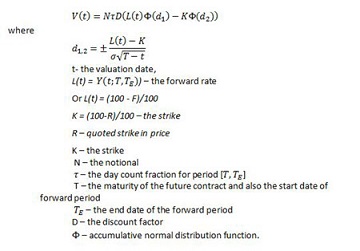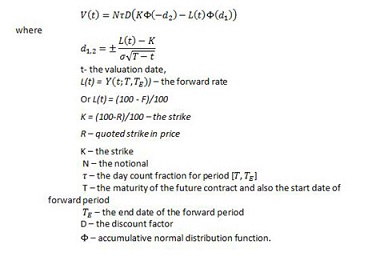Future Option
FinPricing offers:
Four user interfaces:
- Data API.
- Excel Add-ins.
- Model Analytic API.
- GUI APP.
An interest rate future option gives the holder the right but not the obligation to buy or sell an
interest rate future at a specified price on a specified date.
| 1. Interest Rate Future Option Introduction |
Interest rate future options are usually traded in an exchange. The buyer normally can exercise the option on any
business day (American style) prior to expiration by giving notice to the exchange. Option sellers (writer) receive a
fixed premium upfront and in return are obligated to buy or sell the underlying asset at a specified price.
Interest rate future options can be used to hedge against adverse changes in interest rates. In general
futures markets tend to be more liquid than underlying cash markets. This presentation
gives an overview of interest rate future option product and pricing model.
An investor who expected short-term interest rates to decline would also be expecting the price of the
future contracts to increase. Thus, they might be inclined to purchase a 3-month Eurodollar
futures call option to speculate on their belief. The advantage of future options over options of a spot asset stems
from the liquidity of futures contracts. Futures markets tend
to be more liquid than underlying cash markets. Interest rate future options are leveraged instruments.
| 2. Interest Rate Future Option Valuation |
The price of an interest rate option is quoted by the exchange. A model is mainly used for calculating sensitivities
and managing market risk.
Interest rate future options are normally American options. Sometimes, one may use an European option for approximation. In this case, The present value of a call option is given by

The present value of a put option is given by

Pricing an interest rate future option as an American option.
Practical Notes
| References |